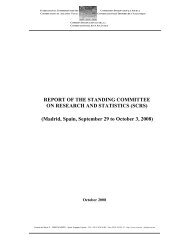E - Iccat
E - Iccat
E - Iccat
Create successful ePaper yourself
Turn your PDF publications into a flip-book with our unique Google optimized e-Paper software.
ADDRESSES & STATEMENTS<br />
comprehensive closed vessel registry with an eye towards ultimately reducing the number of fishing vessels to<br />
an appropriate level. The IATTC is the only tuna RFMO with a closed vessel registry, although current capacity<br />
is well in excess of resource productivity.<br />
ISSF supports the Kobe III call for a freeze in purse seine fishing capacity by developed fishing nations and<br />
creating mechanisms to transfer capacity to developing countries with aspirations to participate in these fisheries.<br />
These steps should be taken now, since scaling back fleet capacity will become even more difficult as new<br />
vessels are introduced. To this end, ISSF urges the following actions:<br />
• ICCAT, IOTC and WCPFC adopt closed vessel registries, especially for the purse seine fleets;<br />
• All tuna RFMOs develop capacity transfer mechanisms to allow for increased participation by developing<br />
countries without an increase in overall capacity, while ensuring effective monitoring and control of the<br />
fisheries;<br />
• All tuna RFMOs establish rules for monitoring and managing the movement of fishing capacity among<br />
the respective Convention areas;<br />
• All tuna RFMOs require unique vessel identifiers (such as IMO numbers), in order to strengthen their<br />
ability to monitor fishing capacity globally through the Consolidated List of Authorized Vessels (CLAV).<br />
ISSF is encouraged by ICCAT’s tightening of the yellowfin and bigeye authorized vessel lists and the addition of<br />
a field in the active vessel register for unique identifiers (e.g., IMO numbers) in 2011. Moving forward, ISSF<br />
urges further effort toward a meaningful cap on fleet capacity to a level commensurate with the productivity of<br />
the ICCAT tuna resources.<br />
Fish Aggregating Device (FAD) Management. Setting on FADs accounts for nearly 40% of global tuna catches<br />
and 50% of global skipjack catches. The time is ripe for a concerted global effort to gather and report to RFMOs<br />
data on FADs (e.g., via logbooks) in order to better monitor FAD usage and to establish a sound basis for their<br />
management in every ocean region. With this information, scientists can advise decision-makers on how to<br />
reduce catches of small tunas and by-catch of non-target species that are commonly associated with FADs.<br />
Providing science bodies with detailed data on FADs and other floating objects can also greatly improve their<br />
stock assessments. However, with the exception of data collected through observer programs, here remains a<br />
lack of information about this type of fishing at the RFMO level. In addition there is a growing understanding of<br />
best practices in FAD construction and by-catch mitigation -developments that ISSF is actively promoting- that<br />
could be implemented in the short term.<br />
According to ICCAT’s 2012 Report of the Standing Committee on Research and Statistics1 in order to<br />
adequately monitor FADs, there are two primary types of information that need to be collected and reported to<br />
RFMO scientific bodies: (i) an inventory and activity record of FADs (“FAD logbook”: FAD markings,<br />
construction specifications, deployment, retrievals, etc.), and (ii) a record of encounters of fishing and supply<br />
vessels with the FADs ("Fishing logbook": catch, by species, that results from sets made on FADs). These two<br />
types of information should be linked through the FAD ID or marking. Using this data, RFMO scientific bodies<br />
can and should advise on any necessary FAD management measures, followed by the development of effective<br />
mechanisms for implementation and compliance monitoring by fishery managers. ISSF urges ICCAT to amend<br />
Recommendation 11-01 so that these FAD data are collected and reported to SCRS.<br />
Action needed<br />
1. Tropical tunas<br />
In 2011, ICCAT adopted TACs for bigeye and yellowfin that are consistent with the advice from SCRS.<br />
According to SCRS, these limits are not being exceeded, but current catches are close and substantial revisions<br />
to recent Ghanaian catches could result in the need to revisit TACs. Therefore, the stocks should be closely<br />
monitored.<br />
The last assessment of the two Atlantic skipjack stocks took place in 2008, using data up to 2006. Though<br />
skipjack stocks are considered to be resilient to overfishing, current catches exceed what the SCRS then<br />
considered to be the upper bound of the estimated MSY. Given the outdated assessment and current high<br />
exploitation rates, ICCAT should mandate a new assessment for the skipjack stocks.<br />
2. Temperate tunas<br />
In 2011, ICCAT adopted TACs for northern and southern albacore that are consistent with the advice from<br />
SCRS. However, it failed to adopt any measures for the Mediterranean stock, which appears to have experienced<br />
59

















